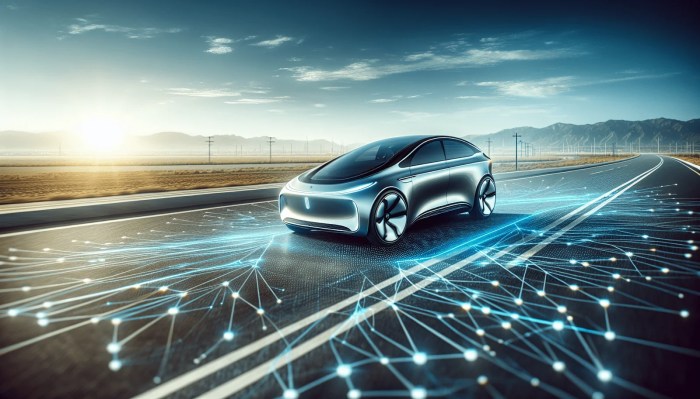Electric Cars Autonomous Driving Features
Electric cars autonomous driving features are rapidly evolving, offering exciting possibilities and posing intriguing challenges. This exploration delves into the advancements, benefits, and potential drawbacks of integrating self-driving technology into electric vehicles. From the initial stages of autonomous driving to the future implications, we’ll cover the key components, safety protocols, and necessary infrastructure.
The integration of autonomous driving features in electric vehicles is transforming the automotive industry. This involves understanding the various levels of autonomy, from basic driver assistance to fully automated driving. We’ll examine the technical aspects, including sensors, software, and the complex interplay of these components.
Introduction to Electric Vehicles and Autonomous Driving
Electric vehicles (EVs) are rapidly gaining popularity, driven by a desire for cleaner transportation and advancements in battery technology. This shift towards EVs is also intertwined with the burgeoning field of autonomous driving, where vehicles are increasingly equipped with advanced sensors and software to navigate without human intervention. The integration of these two technologies is creating a new era of mobility, promising significant changes in transportation systems worldwide.The technological advancements in both EVs and autonomous driving have evolved significantly over the past few decades.
Early EVs faced limitations in range and performance, while autonomous driving systems were primarily focused on specific tasks and environments. However, recent progress has led to more capable and versatile electric vehicles, and autonomous driving features are now being integrated into production models. This evolution highlights a growing synergy between the two technologies.
Evolution of Electric Vehicle Technology
Electric vehicles have a rich history, with various iterations and improvements throughout the years. Early models faced limitations in battery capacity, leading to short driving ranges and slow charging times. Significant advancements in battery chemistry and charging infrastructure have dramatically improved the practicality and appeal of EVs. These advancements have made long-distance travel and everyday commutes more feasible.
Evolution of Autonomous Driving Technologies
Autonomous driving technology has evolved from basic driver assistance systems to more sophisticated, comprehensive systems. Early iterations focused on specific functions like adaptive cruise control and lane keeping assist. These early systems laid the foundation for more advanced capabilities, such as automated parking and fully autonomous navigation.
Integration of Autonomous Driving Features in EVs
The integration of autonomous driving features in electric vehicles is becoming increasingly prevalent. Manufacturers are incorporating advanced driver-assistance systems (ADAS) into EVs to enhance safety and convenience. This integration allows for a smoother and more efficient driving experience, potentially reducing accidents and improving traffic flow.
Table: Key Milestones in EV and Autonomous Driving Technology
| Technology Type | Description | Year of Introduction (approximate) |
|---|---|---|
| Electric Vehicle | Initial models with limited range and performance. | 1890s-1900s |
| Adaptive Cruise Control | Early autonomous driving feature for maintaining a safe distance from the vehicle ahead. | 1990s |
| Lane Keeping Assist | Autonomous driving feature that helps drivers stay within their lane. | 2000s |
| Automated Parking | Autonomous driving features allowing vehicles to park themselves in designated spaces. | 2010s |
| Level 3 Autonomous Driving | Vehicle can operate the vehicle in some circumstances, but human intervention is required in certain conditions. | 2010s – Present |
| Level 4 Autonomous Driving | Vehicles can operate the vehicle in most circumstances, but human intervention is needed in exceptional conditions. | Present |
| Level 5 Autonomous Driving | Vehicle can operate the vehicle in all circumstances without any human intervention. | Future |
Autonomous Driving Features in Electric Vehicles
Autonomous driving features in electric vehicles (EVs) are rapidly evolving, promising significant improvements in safety, efficiency, and convenience. These features are built upon a foundation of advanced sensor technology and sophisticated software algorithms. They represent a significant leap forward in vehicle automation, potentially transforming transportation as we know it.
Autonomous Driving Levels
Autonomous driving features are categorized into different levels, often using the SAE (Society of Automotive Engineers) standard. This standard provides a framework for classifying the degree of automation in a vehicle. Understanding these levels is crucial for assessing the capabilities and limitations of an EV’s autonomous driving system.
- Level 0: No Automation. This level signifies a vehicle that provides no automated driving functions. The driver is solely responsible for all aspects of vehicle operation, including steering, acceleration, and braking.
- Level 1: Driver Assistance. This level offers basic driver assistance features such as adaptive cruise control and lane departure warning. The driver retains full control but receives assistance in specific driving tasks.
- Level 2: Partial Automation. Vehicles at this level can perform tasks such as steering and acceleration/deceleration under specific conditions. The driver must be prepared to take over control immediately when needed. Examples include adaptive cruise control with lane keeping assist.
- Level 3: Conditional Automation. At this level, the vehicle can handle multiple driving functions under certain conditions. The driver must be ready to intervene quickly if necessary, but the vehicle is responsible for certain tasks in limited situations. This often requires the driver to monitor the system and be prepared to take control immediately.
- Level 4: High Automation. In this level, the vehicle can handle most or all driving tasks in specific situations. The driver is not expected to intervene, but the vehicle may still need human intervention in specific cases or unusual conditions. Examples are limited to certain areas with specific conditions.
- Level 5: Full Automation. This represents fully autonomous driving, where the vehicle handles all driving tasks under all conditions without any driver intervention. This level is still under development and faces significant technical and regulatory challenges.
Key Components and Technologies
Autonomous driving systems in EVs rely on a combination of advanced sensors and sophisticated software algorithms. These components work together to perceive the environment, make decisions, and execute actions.
- Sensors. LiDAR (Light Detection and Ranging), radar, and cameras are crucial sensors used to perceive the environment. LiDAR provides precise 3D information about the surroundings, while radar detects objects and their speed and distance. Cameras capture visual information for object recognition and scene understanding.
- Software. Sophisticated algorithms are essential for processing the data collected by the sensors. These algorithms enable the vehicle to understand the environment, make decisions, and control the vehicle’s actions. Machine learning plays a critical role in training these algorithms to recognize and respond to various driving scenarios.
Autonomous Driving Features and Safety Features
The table below summarizes various autonomous driving features and their associated safety features, showcasing how technology enhances safety in electric vehicles.
| Autonomous Driving Feature | Safety Feature Description |
|---|---|
| Adaptive Cruise Control | Maintains a safe following distance and adjusts speed automatically to maintain a preset distance from the vehicle ahead. |
| Lane Keeping Assist | Provides warnings and assistance to maintain the vehicle within its lane. |
| Automatic Emergency Braking | Detects potential collisions and automatically applies brakes to avoid or mitigate an accident. |
| Parking Assistance | Assists with parking maneuvers in tight spaces or parallel parking situations. |
| Traffic Jam Assist | Handles steering, acceleration, and braking in traffic congestion. |
Benefits and Challenges of Combining EVs and Autonomous Driving
The convergence of electric vehicles (EVs) and autonomous driving technology presents a compelling prospect for the future of transportation. This integration promises significant advancements in efficiency, safety, and accessibility, but also introduces new complexities and challenges. This section explores the advantages and obstacles associated with this evolving technology.The integration of autonomous driving features into EVs has the potential to reshape personal and commercial transportation, offering benefits for consumers, manufacturers, and society.
This fusion of advanced technologies aims to optimize existing systems, addressing issues such as traffic congestion, parking challenges, and environmental concerns.
Advantages of Integrating Autonomous Driving Features into EVs
The combined capabilities of EVs and autonomous driving offer numerous advantages, making travel more convenient, safe, and sustainable. These advantages extend to improved fuel efficiency, reduced traffic congestion, and enhanced accessibility for individuals with disabilities.
- Enhanced Safety: Autonomous driving systems, by their very nature, can potentially reduce human error, a leading cause of accidents. Improved reaction times and consistent adherence to traffic laws can translate into a statistically significant decrease in accidents. For instance, Tesla’s Autopilot system, while not fully autonomous, has shown some improvements in accident reduction, though ongoing evaluation is crucial.
- Improved Efficiency: Autonomous vehicles can optimize routes and driving styles, leading to better fuel economy and reduced energy consumption. This is particularly relevant for EVs, where energy efficiency is paramount. Autonomous vehicles can also reduce idling time, further improving efficiency. Real-world examples from companies like Waymo show improvements in route optimization and reduced fuel consumption.
- Increased Accessibility: Autonomous vehicles can enable greater mobility for individuals who cannot drive themselves. This includes people with disabilities, the elderly, and those in remote areas. This has the potential to significantly improve quality of life and reduce social isolation.
- Reduced Congestion and Emissions: Autonomous vehicles, by optimizing traffic flow, can potentially alleviate congestion and reduce overall travel times. This can lead to a significant reduction in emissions, contributing to a cleaner environment.
Potential Benefits for Consumers, Manufacturers, and Society
The benefits of this integration extend beyond individual users. Manufacturers and society as a whole can also reap significant advantages.
- Consumers: Improved safety, convenience, and accessibility are key benefits for consumers. Increased mobility and reduced stress associated with driving are significant advantages. Consumers also benefit from potential cost savings due to reduced fuel consumption and maintenance.
- Manufacturers: The development and production of autonomous EVs create new market opportunities and drive innovation. This can lead to the creation of new jobs and economic growth in related sectors, such as software development and sensor technology.
- Society: The integration of these technologies can improve urban planning, enhance public transportation systems, and contribute to a more sustainable future. This includes a potential reduction in traffic congestion and air pollution.
Challenges and Obstacles
Despite the numerous advantages, several challenges and obstacles need to be addressed. Addressing safety concerns, ethical dilemmas, and regulatory hurdles is critical for successful implementation.
- Safety Concerns: Autonomous systems are still under development, and their safety performance in all conditions remains to be fully proven. The integration of complex systems with potential failure points needs careful scrutiny. Accidents involving autonomous vehicles, even if rare, can have severe consequences. Examples of accidents in real-world deployments of autonomous systems are valuable for future development and refinement.
- Ethical Dilemmas: Autonomous vehicles face complex ethical choices in critical situations, requiring pre-programmed decision-making rules. These rules can have unintended consequences and must be developed carefully to ensure fairness and justice. For example, if an accident is unavoidable, how do you program the vehicle to choose between different levels of risk?
- Regulatory Hurdles: The lack of clear and consistent regulations for autonomous vehicles across different jurisdictions can hinder widespread adoption. Establishing clear guidelines for testing, deployment, and liability is crucial for the smooth integration of these technologies.
Comparison Table: Integrating EVs and Autonomous Driving
| Factor | Pros | Cons |
|---|---|---|
| Safety | Reduced human error, improved reaction time | Potential for system failures, safety concerns in various conditions |
| Efficiency | Optimized routes, reduced energy consumption | Development costs, battery technology limitations |
| Accessibility | Increased mobility for individuals with disabilities | Ethical dilemmas in critical situations, potential for job displacement |
| Environment | Reduced emissions, improved air quality | Regulatory uncertainties, infrastructure requirements |
Safety and Reliability Considerations

Source: evhighlights.com
Autonomous driving in electric vehicles (EVs) demands a robust safety framework. The integration of advanced driver-assistance systems (ADAS) and sophisticated algorithms necessitates a meticulous approach to ensuring both the safety and reliability of these systems. A critical aspect of this integration is the prioritization of safety throughout the entire development lifecycle.The safety mechanisms in place, coupled with the ongoing efforts to enhance reliability, aim to minimize the risk of accidents and ensure a safe and dependable driving experience for all users.
The challenge lies in achieving a balance between the ever-evolving technological capabilities and the need for comprehensive safety protocols.
Safety Mechanisms and Protocols
The development of autonomous driving features in EVs involves multiple layers of safety mechanisms. These systems are designed to detect and react to potential hazards in real-time. Redundant sensors and algorithms are often employed to enhance the reliability of the system and provide backup capabilities in case of failure. Crucially, these safety systems are rigorously tested under various conditions to validate their effectiveness and ensure that they meet the highest safety standards.
Reliability of Autonomous Driving Systems
The reliability of autonomous driving systems is paramount. Failures can have significant consequences, and therefore, thorough testing and validation are crucial. Factors like sensor malfunction, unexpected environmental conditions, or software glitches can all potentially lead to system failures. To mitigate these risks, engineers employ sophisticated redundancy and fail-safe mechanisms. Regular maintenance and software updates are also essential for ensuring ongoing reliability and to address any identified vulnerabilities.
Prioritization of Safety in Development
Safety is paramount in the design and development process. Rigorous testing protocols are implemented at every stage, from initial algorithm design to final vehicle deployment. Safety engineers work closely with software and hardware developers to identify and mitigate potential risks. Safety is not an afterthought but an integral part of the design and development process. This includes comprehensive simulations, real-world testing, and validation of system responses under various challenging conditions.
Safety Protocol Effectiveness
The effectiveness of safety protocols is continually evaluated. This evaluation process includes analyzing accident reports, simulating various scenarios, and gathering feedback from users and experts. Improvements to the safety protocols are made based on these evaluations and real-world data. Regular updates to the software and algorithms are designed to enhance the system’s ability to adapt to changing conditions and improve its overall effectiveness.
| Safety Protocol | Description | Effectiveness |
|---|---|---|
| Redundant Sensors | Multiple sensors (cameras, radar, lidar) provide backup and cross-validation | High. Redundancy reduces the risk of single point failure. |
| Fail-Safe Mechanisms | Pre-programmed responses to critical failures or sensor errors | High. These mechanisms help the vehicle maintain control in unexpected situations. |
| Advanced Driver-Assistance Systems (ADAS) | Systems that assist the driver with tasks such as lane keeping and collision avoidance. | Medium to High. Effectiveness depends on the complexity of the ADAS and the consistency of its data. |
| Regular Software Updates | Fixes bugs and improves algorithms, often addressing safety concerns. | High. Proactive updates enhance the system’s ability to adapt and react to new challenges. |
Infrastructure Requirements for Autonomous Driving in EVs: Electric Cars Autonomous Driving Features
The widespread adoption of autonomous electric vehicles (AEVs) hinges critically on a robust supporting infrastructure. This infrastructure must address the unique needs of AEVs, encompassing charging, communication, and road design. Effective infrastructure is essential for ensuring safety, reliability, and ultimately, the successful integration of AEVs into our transportation systems.
Essential Components of Autonomous Driving Infrastructure
The infrastructure supporting AEVs comprises several interconnected components, each playing a crucial role in enabling safe and efficient operation. These elements are crucial for seamless integration of autonomous vehicles into the existing transportation network.
Charging Infrastructure
Adequate charging infrastructure is paramount for AEVs. The availability of fast-charging stations, strategically placed across urban and rural areas, is essential to accommodate the increased demand. Furthermore, charging infrastructure must consider the diverse needs of AEV owners, from home charging to public access points. This includes optimizing charging rates and minimizing downtime for drivers. The presence of readily accessible and well-maintained charging stations is vital for promoting public acceptance of AEVs.
Communication Networks
Reliable communication networks are fundamental for autonomous driving. These networks facilitate communication between vehicles, infrastructure, and control systems. 5G and other advanced wireless technologies are crucial to support the high bandwidth and low latency requirements of autonomous driving. Effective communication enables vehicles to share real-time data, ensuring seamless coordination and responsiveness to changing traffic conditions. Robust communication networks minimize the risk of collisions and improve overall safety.
Road Infrastructure
Road infrastructure must be adapted to accommodate AEVs. This includes the implementation of standardized markings, clear signage, and dedicated lanes for autonomous vehicles. Integration of sensor infrastructure, like embedded sensors in road surfaces, is important for collecting data and providing feedback to the vehicles. The integration of these technologies allows for real-time data collection and analysis, enabling autonomous vehicles to adjust their operation in response to dynamic traffic conditions.
Furthermore, the infrastructure should be designed for durability and long-term maintenance to ensure safety and reliability.
Impact on Urban Planning and Transportation Systems
Autonomous driving will fundamentally alter urban planning and transportation systems. The increased efficiency of traffic flow, potentially leading to reduced congestion and improved travel times, is a significant advantage. Urban planning can adapt by optimizing road layouts and allocating space for autonomous vehicle infrastructure. This may include dedicated lanes or designated parking areas for AEVs. Efficient and coordinated traffic management systems are necessary to support the transition.
Conceptual Diagram of Autonomous EV Infrastructure
| Component | Description | Interconnections |
|---|---|---|
| Charging Stations | Fast-charging stations strategically placed across the city | Connected to power grid, communication network, and AEVs |
| Communication Network | High-bandwidth wireless networks, such as 5G | Connects AEVs, infrastructure, and control systems |
| Road Infrastructure | Roads with embedded sensors, standardized markings, and signage | Provides data to AEVs and supports navigation |
| Control System | Centralized system for managing and coordinating AEVs | Receives data from sensors, communication network, and road infrastructure |
| AEVs | Autonomous electric vehicles | Communicates with other vehicles and infrastructure, draws power from charging stations |
Future Trends and Predictions
The integration of autonomous driving features with electric vehicles (EVs) is poised for significant advancements in the coming years. These advancements will reshape the automotive industry and society, bringing about profound changes in transportation, infrastructure, and even urban planning. The transition to more autonomous and electric vehicles is not simply a technological shift; it’s a fundamental change in how we interact with our environment.
Potential Advancements in Autonomous Driving Features
Autonomous driving technology is continuously evolving, with ongoing research and development leading to enhanced capabilities. Future advancements will focus on improving the sophistication of perception systems, enhancing decision-making algorithms, and refining the vehicle’s interaction with complex and dynamic environments. This includes sophisticated sensor fusion for more accurate and comprehensive environmental awareness, leading to more responsive and reliable autonomous systems.
Anticipated Impact on the Automotive Industry, Electric cars autonomous driving features
The integration of autonomous driving features into EVs will profoundly affect the automotive industry. Manufacturers will need to adapt their production processes, develop new skillsets within their workforce, and focus on creating robust and reliable software solutions. This transition will create new market opportunities for software companies, sensor manufacturers, and other related industries. Existing car manufacturers will need to adapt to the new requirements, leading to potentially disruptive business models.
The traditional ownership model of cars might also undergo significant change.
Anticipated Impact on Society
The adoption of autonomous EVs will have far-reaching impacts on society. Reduced traffic congestion, improved traffic flow, and potential reductions in accidents are just some of the anticipated benefits. Increased accessibility to transportation for individuals with disabilities or mobility limitations is also a significant consideration. However, concerns about job displacement and the ethical implications of autonomous decision-making need careful consideration and mitigation strategies.
Emerging Technologies and Their Applications
Several emerging technologies will play crucial roles in shaping the future of autonomous EVs. Sophisticated sensor fusion, leveraging data from LiDAR, radar, cameras, and ultrasonic sensors, will allow for a more holistic and accurate understanding of the surrounding environment. Machine learning and artificial intelligence will be essential for enabling the vehicle to learn and adapt to new situations and challenges, allowing for better decision-making.
Advanced communication systems, such as 5G and future wireless technologies, will enable vehicles to communicate more effectively with each other and with infrastructure, contributing to smoother and safer traffic flow.
Illustrative Visual Representation of Future Trends
A flowchart depicting the evolution of autonomous EV technology could start with Level 0 (no automation) and progress through Levels 1-5 (full automation). Each level would be connected to potential advancements, such as improved sensor technologies, more sophisticated algorithms, and enhanced communication systems. The flowchart would demonstrate how these advancements contribute to greater levels of autonomy, ultimately culminating in a future where vehicles can operate entirely autonomously.
An infographic, illustrating the projected market share for autonomous EVs over time, would also be useful. This would display the growth trajectory of autonomous EV adoption, highlighting the expected surge in popularity as the technology matures.
Ethical Considerations and Societal Impact
Autonomous electric vehicles, while promising advancements in transportation, present complex ethical and societal challenges. These vehicles’ decision-making processes, especially in critical situations, require careful consideration of potential biases and impacts on vulnerable populations, as well as the wider implications for the workforce. Understanding these issues is crucial for responsible development and deployment of this technology.The development and implementation of autonomous vehicles raises profound ethical questions.
These self-driving systems, relying on complex algorithms, may make difficult decisions in unexpected circumstances, requiring pre-programmed rules and priorities that must be critically examined to ensure fairness and safety for all. The potential for unintended consequences and bias in algorithms demands careful scrutiny and ongoing dialogue among stakeholders.
Ethical Dilemmas in Autonomous Driving
The ethical quandaries surrounding autonomous vehicles are multifaceted. Algorithms, trained on vast datasets, can inadvertently reflect societal biases present in the data, leading to discriminatory outcomes. For instance, if the training data disproportionately depicts certain demographics in risky situations, the algorithm might prioritize avoiding collisions with these groups, potentially endangering them in unforeseen circumstances. This requires meticulous attention to the data used to train algorithms and continuous evaluation for potential biases.
Furthermore, determining the appropriate response in unavoidable accidents, such as choosing between injuring a pedestrian or a passenger, remains a complex ethical challenge. Establishing clear, transparent protocols and guidelines is essential to address these issues proactively.
Societal Impact of Autonomous Vehicles
The societal impact of autonomous vehicles extends beyond ethical dilemmas. A significant concern is the potential displacement of jobs associated with traditional transportation. Taxi drivers, truckers, and delivery personnel, for example, could face unemployment as autonomous vehicles take over these roles. This necessitates proactive measures to retrain and reskill affected workers, potentially shifting the workforce towards roles in the maintenance, repair, and development of autonomous vehicle technology.
Potential for Bias in Algorithms
Algorithms trained on existing data can reflect existing societal biases. If the data predominantly depicts one demographic in risky situations, the algorithm might be programmed to prioritize avoiding collisions with that group, potentially endangering others. Ensuring diverse and representative datasets in the training process is crucial to mitigate this risk and promote fairness.
Impact on Vulnerable Populations
Autonomous vehicles, with their complex decision-making processes, can disproportionately affect vulnerable populations. Consider, for example, pedestrians with visual impairments or those in crowded areas. The algorithm’s response to these situations must be carefully designed to avoid exacerbating existing inequalities. The potential for bias in the algorithms must be meticulously examined and mitigated to ensure equitable outcomes.
Job Displacement and Workforce Adaptation
The automation of transportation through autonomous vehicles could lead to job displacement in various sectors. Taxi drivers, truckers, and delivery personnel are potential examples. Proactive measures to reskill and retrain affected workers are essential. This transition requires substantial investment in education and training programs, potentially creating new roles in the maintenance, repair, and development of autonomous vehicle technology.
Ethical Questions and Potential Answers Regarding Autonomous Driving
- Question: In an unavoidable accident, how should an autonomous vehicle prioritize between injuring a pedestrian and a passenger?
- Answer: This ethical dilemma requires pre-programmed decision rules based on factors like the severity of potential injuries, age, and other relevant criteria. This requires rigorous ethical review and public consultation.
- Question: How can biases in training data be minimized to ensure fair and equitable outcomes for all users?
- Answer: The training datasets for autonomous vehicles must be meticulously analyzed for potential biases. Active measures, including data augmentation and diversity initiatives, are necessary to ensure representation from diverse populations and scenarios.
- Question: What are the long-term implications of autonomous vehicles on employment and the workforce?
- Answer: Autonomous vehicles have the potential to significantly impact the workforce. Proactive measures to retrain and reskill workers in emerging fields related to autonomous vehicle technology, such as maintenance and development, are essential.
Last Word
In conclusion, the convergence of electric vehicles and autonomous driving promises a future of safer, more efficient, and potentially revolutionary transportation. However, significant challenges remain, including safety concerns, ethical dilemmas, and the need for robust infrastructure. Ultimately, this integration will reshape personal mobility, impacting consumers, manufacturers, and society as a whole.













Post Comment